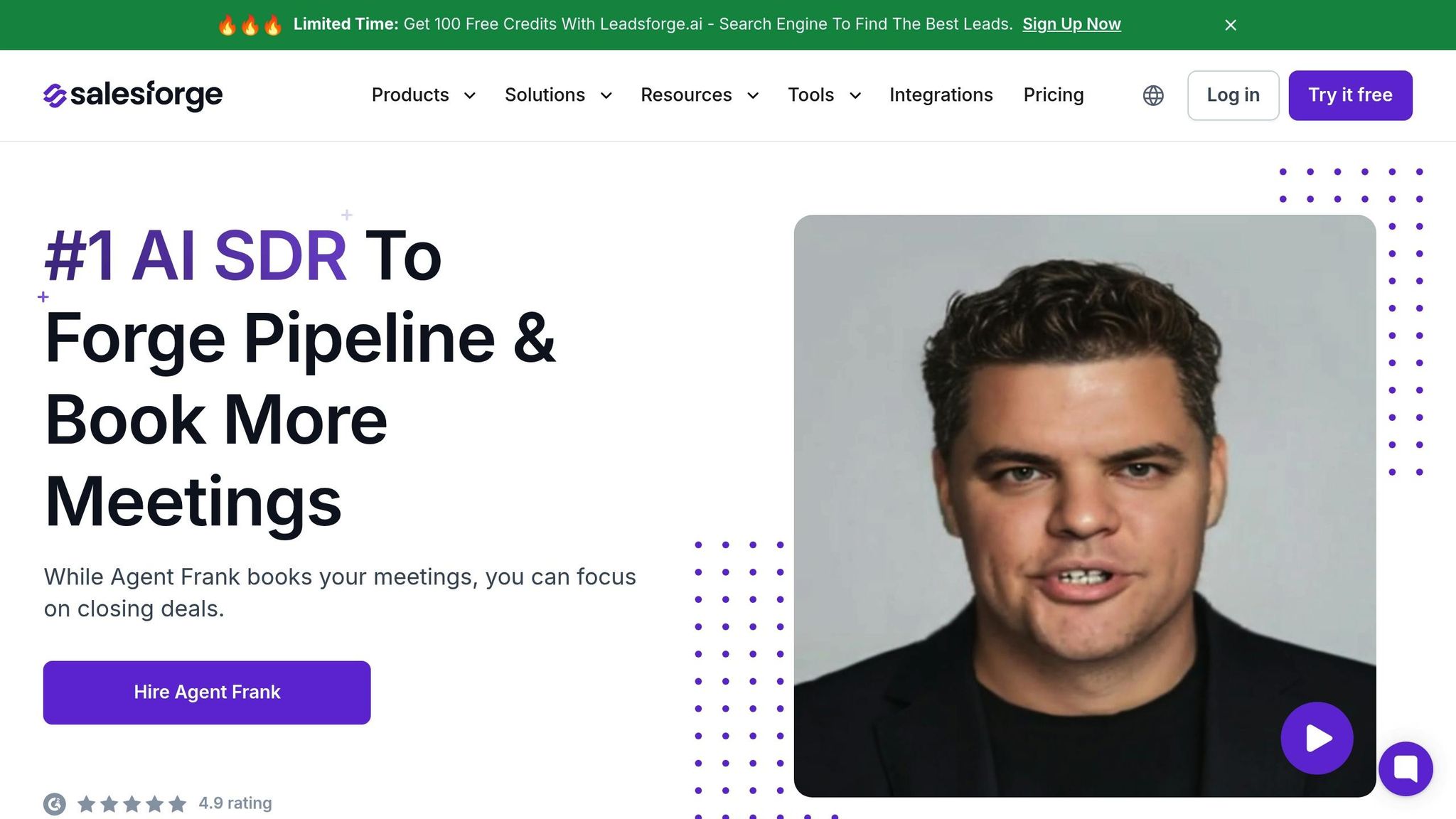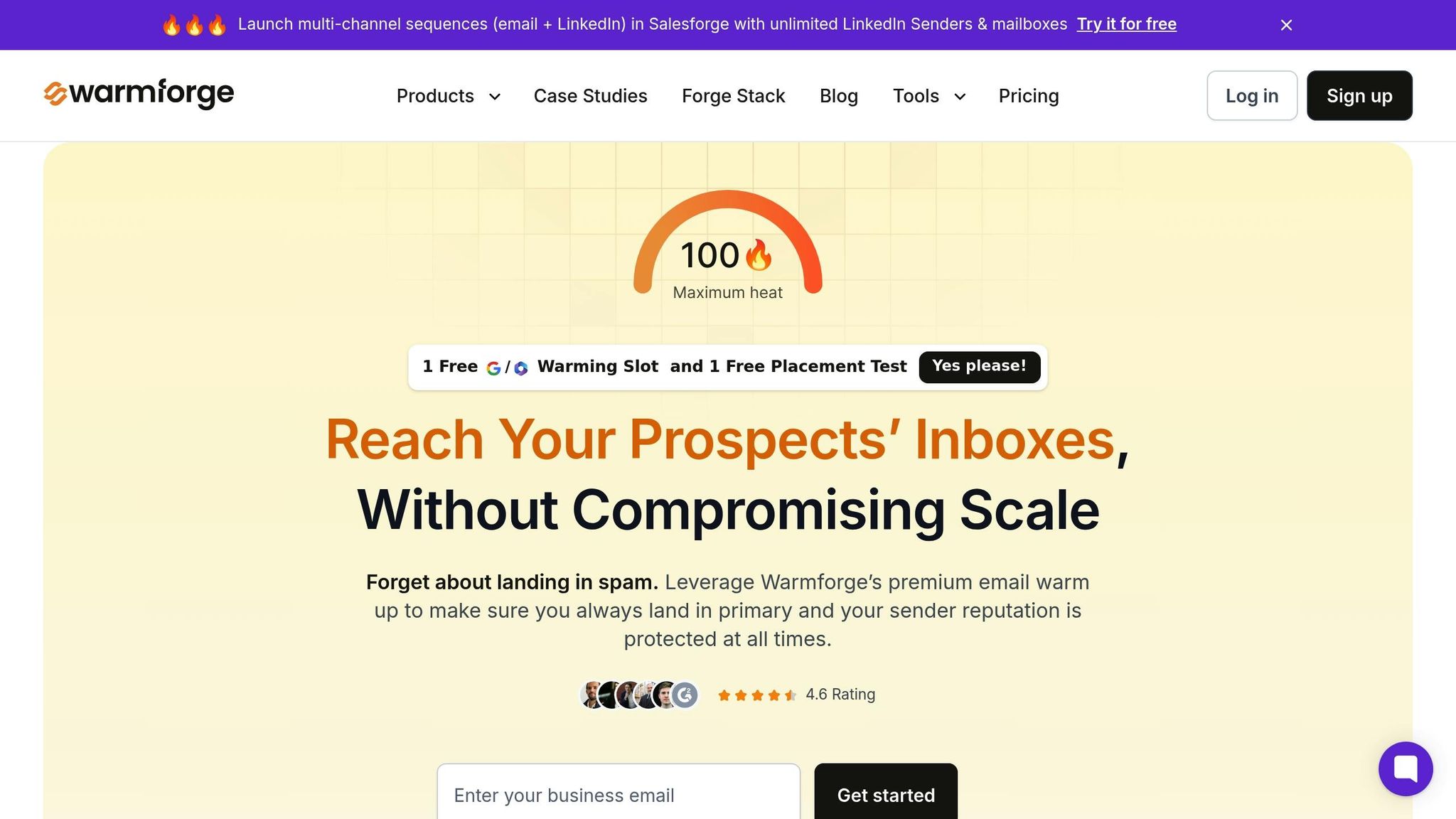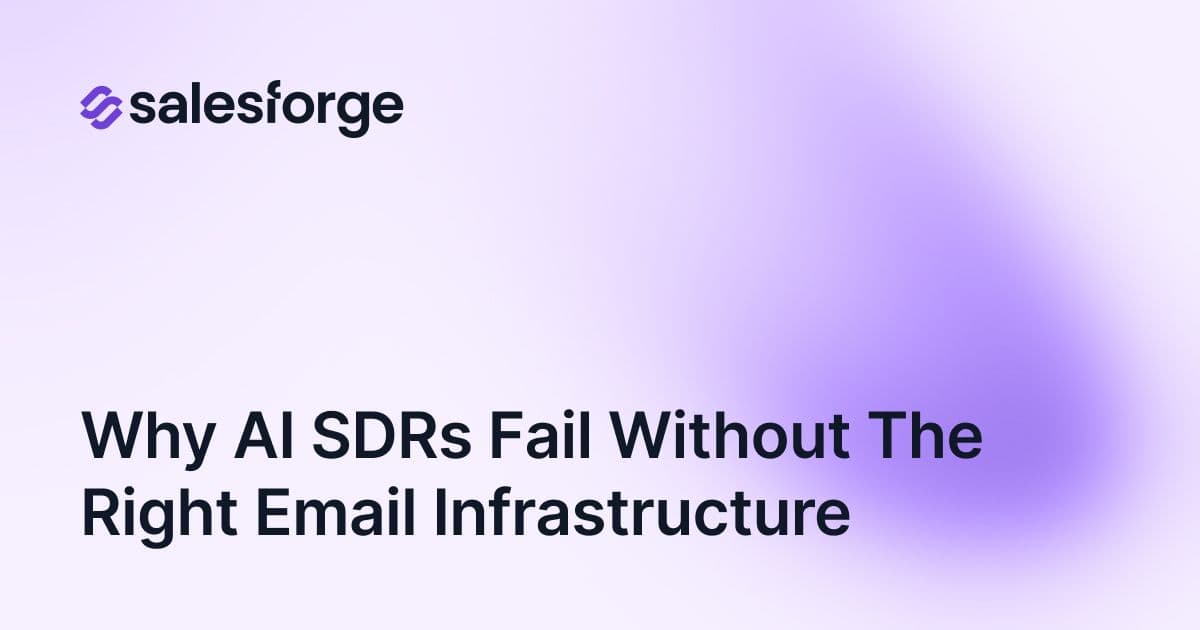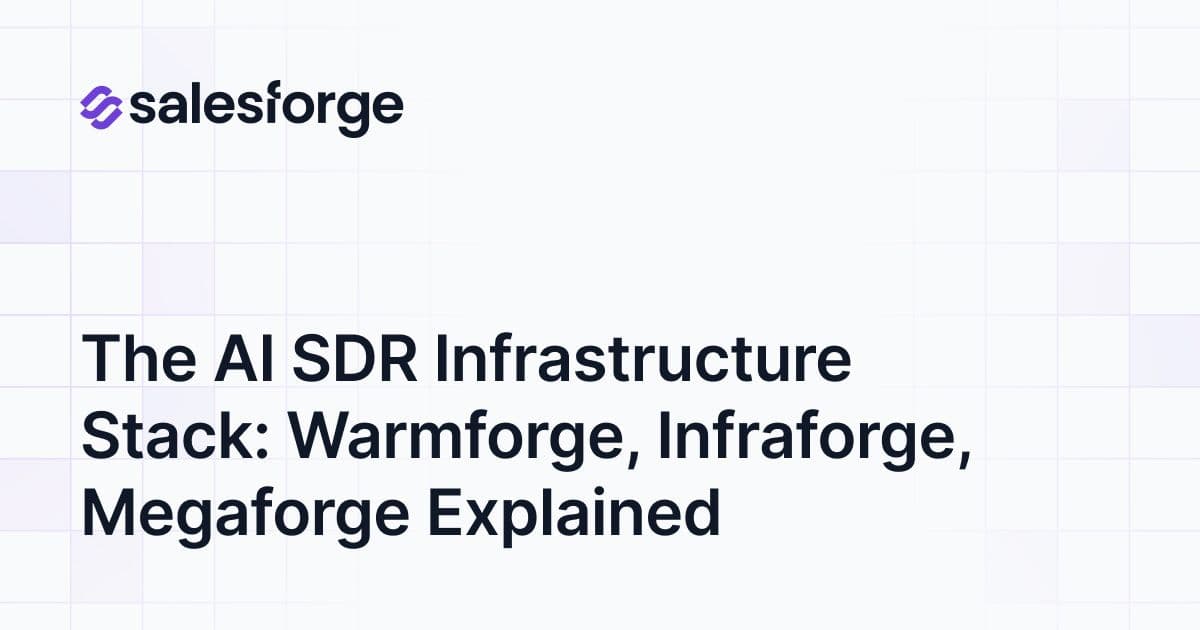Beginner’s Guide to Email Infrastructure For AI SDRs That Actually Delivers
Your AI SDR is only as effective as its email infrastructure. Without the right setup, even the smartest tools will fail to deliver messages to inboxes. Here’s what you need to know:
- Email infrastructure ensures messages land in inboxes, not spam. It includes domains, mailboxes, IP addresses, warm-up processes, and sender reputation.
- Key components like domain trust, mailbox limits, and reputation management are critical for success.
- Platforms like Salesforge offer tools such as Warmforge (email warm-up), Infraforge (dedicated infrastructure), and Megaforge (premium infrastructure created specifically for Agent Frank to boost email deliverability. Megaforge auto distributes sending across multiple ESPs, so if one burns, there’s a fallback) to optimize deliverability.
- Poor infrastructure can cause deliverability issues, wasting time and resources. For example, a drop from 85% to 30% deliverability could mean losing over half your audience.
Bottom line: A strong email infrastructure is essential for scaling outreach and ensuring your AI SDR, like Agent Frank, achieves its full potential. Without it, even the best AI will underperform.
Email Infrastructure Basics: The Foundation of Outreach
What Is Email Infrastructure?
Picture email infrastructure as the digital highway system that ensures your messages travel smoothly from sender to recipient. Just like a car needs a reliable network of roads, your AI SDR (Sales Development Representative) requires a well-built setup to ensure emails land in inboxes rather than disappearing into spam folders.
At its core, email infrastructure includes all the behind-the-scenes elements that come into play when you hit "send." This involves domains, mailboxes, IP addresses, warm-up processes, and reputation systems. Together, these components determine whether your emails reach their intended destination.
For AI SDRs like Agent Frank, this infrastructure is absolutely essential. While Frank can create highly personalized emails and manage intricate follow-up workflows, none of that matters if the emails don’t make it to the prospect’s inbox. Without a strong infrastructure, even the smartest AI is powerless - its messages simply won’t get delivered.
Key Components of Email Infrastructure
There are five main building blocks that make up email infrastructure:
- Domains: Think of these as your digital return address. When recipients see your domain (e.g., @yourcompany.com), their email provider evaluates it for trustworthiness. A new domain with no history might raise red flags, making it harder for your emails to get through.
- Mailboxes: These are the email accounts that actually send your messages. Each mailbox has its own sending limits and reputation. To scale outreach effectively, especially with new accounts, multiple mailboxes are often coordinated to avoid hitting daily limits.
- IP Addresses: Every email you send originates from a specific IP address, which acts like your location on the internet. Email providers track the reputation of these IPs closely. Using shared IPs can be risky - if someone else on the same IP sends spam, it could harm your deliverability too.
- Warm-up: This is the gradual process of building trust with email providers like Gmail or Outlook. New domains and mailboxes start with no reputation, so they need to slowly increase sending volume while maintaining positive engagement (such as responses or opens). This process typically takes about two weeks.
- Sender Reputation: Think of this as your email credit score. It’s built over time through consistent, legitimate sending practices. High bounce rates, spam complaints, or sudden spikes in email volume can hurt your reputation, making it harder for your messages to reach inboxes.
These elements work together to ensure that an AI SDR’s outreach efforts are effective, helping messages get delivered instead of being flagged or ignored.
Why Email Infrastructure Matters for AI SDRs
The strength of your email infrastructure directly impacts the scalability and success of your outreach. Even the most skilled driver needs a reliable car, and the same goes for AI SDRs - they need a solid infrastructure to perform at their best.
AI SDRs like Agent Frank are designed to send hundreds or even thousands of emails daily, targeting prospects across various campaigns. At this scale, the benefits of a well-built infrastructure are amplified - but so are the risks of a poorly configured setup. A small mistake, like a misconfigured domain or a mailbox that hasn’t been properly warmed, can derail an entire campaign, wasting weeks of effort.
For example, imagine you’re reaching out to 1,000 prospects. If your deliverability drops from 85% to 30%, you’ve just lost the ability to connect with over half your audience. This isn’t just a technical glitch - it’s a missed opportunity that could directly affect revenue.
Additionally, AI SDRs operate independently, which means issues can snowball quickly without human oversight. Unlike human SDRs who might notice if their emails aren’t getting responses, an AI could keep sending messages into spam folders indefinitely unless the underlying problems are fixed.
Even the most advanced AI features - like personalized messaging and follow-up sequences - are useless if they’re not backed by properly configured domains, well-coordinated mailboxes, and a strong sender reputation. That’s why platforms like Salesforge prioritize tools like Warmforge, Infraforge, and Megaforge. These systems ensure the AI has the solid foundation it needs to deliver results.
<script>(function(d,u,ac){var s=d.createElement('script');s.type='text/javascript';s.src='https://a.omappapi.com/app/js/api.min.js';s.async=true;s.dataset.user=u;s.dataset.campaign=ac;d.getElementsByTagName('head')[0].appendChild(s);})(document,372145,'tu1or50rqqejh816h1cm');</script>
Agent Frank's Setup: How Salesforge Powers Reliable AI Outreach

Now that we've covered the basics of email infrastructure, let's dive into how Agent Frank - Salesforge's AI-powered SDR - uses these principles in action. Agent Frank doesn’t just rely on artificial intelligence; he’s backed by a strong infrastructure, much like a race car driver depends on a finely tuned vehicle and a skilled pit crew.
Warmforge: Establishing Trust With Email Providers

One of the key tools in Frank's toolkit is Warmforge, Salesforge's built-in email warm-up system that comes standard with every setup. Warmforge tackles a common hurdle for new email accounts: earning credibility with major providers like Gmail and Outlook. Over a 14-day period, it simulates typical business interactions to help email providers view your mailboxes as legitimate.
Its "Always-On Warm Up" feature ensures your sender reputation stays intact, even during active campaigns. Plus, the Deliverability Boost keeps an eye on email performance during warm-up and automatically removes any messages that land in spam folders, further solidifying trust with inbox providers. On top of that, ongoing Health Checks monitor crucial elements like DNS settings, MX records, and blacklist status, allowing you to address potential spam risks before they escalate.
For Agent Frank, this means that every outreach campaign begins with mailboxes that already have a strong reputation. This significantly increases the chances of his emails landing in the primary inbox, where they’re most likely to be seen. While Warmforge builds trust, Infraforge provides the control needed for high-volume, precision outreach.
Infraforge: Dedicated Infrastructure for Maximum Control

For users who demand complete control over their email setup, Infraforge offers a private, dedicated infrastructure solution. With Infraforge, you have full ownership of your email system, including dedicated IP addresses, automated DNS configurations for email authentication, and control over domain warm-up processes. This isolation ensures that your sending reputation remains protected and tailored to your specific needs.
Designed for high-volume outreach, Infraforge includes advanced features like SSL and domain masking, which protect your primary domain by creating secure, masked versions for campaigns. Additionally, multi-IP provisioning allows you to spread email volume across multiple dedicated IP addresses, reducing the risk of overloading any single IP.
Pricing for Infraforge starts at $17 per mailbox per month (billed annually) for a minimum of 10 mailboxes. Additional costs include $70 per year per domain for hosting, $99 per month per dedicated IP, and $6 per month per domain for SSL domain masking when billed annually. While this setup requires a higher upfront investment compared to shared solutions, it delivers the reliability and control that agencies and high-volume users need.
Together, Warmforge and Infraforge give Agent Frank everything he needs to succeed. Warmforge builds trust with email providers, while Infraforge provides enterprise-grade control and scalability, ensuring that Frank’s AI-driven outreach is both reliable and effective. This combination creates a strong foundation for seamless, high-impact campaigns.
Scaling Outreach: How to Match Infrastructure to Your Goals
Your email infrastructure should align with your outreach goals. What works for a small startup sending a few hundred emails a month won’t suffice for an agency juggling campaigns for multiple clients. It’s like picking the right vehicle: a bicycle is perfect for short trips, but moving furniture requires a truck. The same principle applies to scaling your email operations.
How Many Mailboxes Do You Need?
Planning your mailboxes is simple once you know the basics. Stick to a limit of 15 emails per day per mailbox. Sending more risks triggering spam filters and damaging your domain's reputation.
Here’s how the math works out:
- 10 mailboxes: 150 emails/day or 4,500 emails/month
- 20 mailboxes: 300 emails/day or 9,000 emails/month
For businesses just starting with AI-powered SDRs, 10 mailboxes are usually enough to reach thousands of prospects each month while keeping your sender reputation intact. However, if you’re aiming for aggressive growth - like reaching 1,000 prospects monthly with multiple follow-ups - you’ll need to scale up to 20 or more mailboxes to meet your outreach goals.
Comparing Private vs. Multi-ESP Infrastructure
When scaling your outreach, you’ll need to choose between two infrastructure setups: Infraforge’s private system or Megaforge’s multi-ESP solution. Each has its strengths, and the right choice depends on your specific needs.
Infraforge offers complete control over your email setup. With dedicated IP addresses and domain authentication, you can isolate your sending reputation from others. This makes it ideal for agencies managing multiple clients or businesses that require granular control. Pricing starts at $33 per month (billed annually) for 10 mailboxes. While the upfront setup is more technical, Infraforge provides the reliability needed for advanced outreach using tools like Agent Frank.
Megaforge, on the other hand, spreads your emails across multiple providers such as Gmail, Outlook, Mailforge, and Infraforge. If one provider experiences issues, the system automatically shifts the volume to keep things running smoothly. This redundancy is perfect for AI SDRs like Agent Frank, ensuring consistent delivery without manual intervention. Megaforge starts at $69 per month for 20 mailboxes, offering automation and failover protection to handle scaling with ease.
| Feature | Infraforge | Megaforge |
|---|---|---|
| Control Level | Complete ownership and control | Automated management across providers |
| Starting Price | $33/month for 10 mailboxes (annual billing) | $69/month for 20 mailboxes |
| Best For | Agencies, high-volume users | AI SDR automation, consistent delivery |
| Setup Complexity | Technical setup required | Fully automated setup |
| Redundancy | Single infrastructure | Multi-ESP failover protection |
While Infraforge gives you dedicated control, Megaforge ensures consistent delivery through automated redundancy.
Both options include Warmforge’s automatic reputation-building feature, ensuring your mailboxes start with strong credibility. Whether you opt for Megaforge’s automation or Infraforge’s dedicated resources, your infrastructure can grow alongside your business needs. Many users begin with Megaforge for its simplicity and later integrate Infraforge when campaigns demand more control and customization.
Deliverability: The Key to AI SDR Success
Even the smartest AI SDR won't make an impact if its emails never make it to a prospect's inbox. Deliverability is the backbone of any successful outreach effort, ensuring your messages actually get seen.
What Is Deliverability?
Deliverability is all about how often emails from tools like Agent Frank land in the recipient's primary inbox instead of getting lost in spam folders, promotions tabs, or being blocked altogether. Think of it as the success rate of your email delivery - no matter how great your message is, it’s useless if it never reaches the right eyes.
Email providers like Gmail, Outlook, and Yahoo use complex algorithms to evaluate incoming emails. These algorithms consider things like your sender reputation, domain history, email content, and engagement rates to determine where your email ends up. When deliverability is strong, most of Agent Frank’s emails make it to the inbox. But when it’s weak, a large chunk of those emails can get filtered out, derailing your entire campaign.
This is especially crucial for AI SDRs like Agent Frank. While a human sales rep might send 20–30 emails a day, AI SDRs can handle hundreds - or even thousands - of prospects at once. If deliverability takes a hit, it’s not just a handful of missed opportunities - it’s potentially thousands of undelivered messages and a damaged domain reputation. That’s why Salesforge has developed tools to ensure top-tier deliverability.
How Salesforge Protects Deliverability
Salesforge’s system is built with a three-layered approach to safeguard your sender reputation and keep your emails landing where they belong - in the inbox. Each layer plays a unique role in maintaining trust and reliability for Agent Frank’s outreach.
- Warmforge: This step establishes trust with email providers over a 14-day period. Instead of sending a flood of emails from a new domain right away, Warmforge mimics natural email activity by sending and receiving messages. This gradual warm-up helps position your mailboxes as legitimate, ensuring Agent Frank starts off with a solid reputation.
- Infraforge: By providing dedicated IPs and a controlled sending environment, Infraforge shields your campaigns from being affected by issues caused by other users. This isolation is a game-changer for high-volume email campaigns, keeping your reputation intact.
- Megaforge: Megaforge takes it further by spreading Agent Frank’s emails across multiple providers. If one provider encounters issues or updates its filtering rules, Megaforge automatically shifts the load to another provider. This redundancy keeps your outreach consistent, even when external factors come into play.
These layers work together to create a self-healing email system. If one part of the system detects an issue - like a flagged domain or IP problem - the other layers step in to keep things running smoothly. This ensures Agent Frank’s outreach remains reliable, even when challenges arise behind the scenes.
Thanks to this integrated approach, Agent Frank’s emails consistently find their way into inboxes, making sure your outreach efforts don’t go to waste.
Conclusion: Brains Need Backbone
Even the smartest AI SDR is only as effective as the infrastructure supporting it. Agent Frank may have the ability to craft tailored emails, pinpoint the right prospects, and manage intricate follow-up sequences. But without a solid email setup, those advanced capabilities fall flat.
The key to an AI SDR that delivers results - rather than one that gets flagged or burns through domains - lies in its infrastructure. From a 14-day warm-up process that builds credibility with inbox providers to multi-ESP redundancy that ensures campaigns run without interruptions, every piece plays a critical role.
This is where Salesforge stands out. While many platforms focus on either intelligent AI or reliable infrastructure, Salesforge combines both seamlessly. Agent Frank handles the “brains” of the operation, taking care of prospecting, personalization, and follow-ups autonomously. At the same time, tools like Warmforge, Infraforge, and Megaforge provide the “backbone,” ensuring those actions land where they’re supposed to - your prospects’ inboxes.
This unified system removes the need to become an email deliverability expert or juggle multiple vendors. Instead, you get a streamlined solution where Agent Frank works hand-in-hand with a robust infrastructure to turn prospects into genuine opportunities.
Whether you’re a founder exploring AI SDR tools, an agency scaling outreach for clients, or a sales team aiming to automate repetitive tasks, the takeaway is clear: AI alone isn’t enough - it needs strong infrastructure to succeed. Without both, you risk poor results and potential damage to your reputation.
Curious about leveling up your outreach? Check out Salesforge’s solution to see how this integrated approach can redefine your AI SDR experience. The future isn’t just about smarter AI - it’s about AI that delivers real results. Learn how Salesforge can transform your sales strategy today.
FAQs
How can I make sure my AI SDR’s emails land in the primary inbox instead of the spam folder?
To make sure your AI SDR's emails land in the primary inbox and not the spam folder, it's all about earning the trust of inbox providers. Start by gradually warming up your email accounts to build a solid reputation. A tool like Warmforge can help automate this process over a two-week period.
Stick to best practices like sending fewer, high-quality emails - aim for no more than 200 per mailbox daily. Avoid repetitive subject lines, and keep email sequences short, especially for audiences that aren't a top priority. It's also crucial to regularly clean and validate your contact lists to steer clear of invalid addresses. On top of that, check your sender reputation monthly to keep your email performance on track.
When you pair these tactics with a reliable email infrastructure, your AI SDR can deliver messages effectively while keeping deliverability rates high.
What’s the difference between Infraforge and Megaforge, and how do I choose the right one for my business?
Infraforge offers a private email infrastructure tailored for users who want complete control over their email setup. It's a great choice for agencies or businesses that require advanced options like SSL, domain masking, and multi-IP provisioning. These features help ensure high deliverability rates and provide isolation from shared systems.
On the flip side, Megaforge is a fully managed, multi-ESP platform that automatically spreads email sending across multiple providers, such as Gmail and Outlook. This setup is especially useful for businesses leveraging AI SDRs, as it maintains reliable performance even if one provider faces limitations or performance issues.
Choosing between the two depends on your priorities: if you need full control and customization, Infraforge is the way to go. But if you're looking for a hands-off, scalable solution for AI SDR automation, Megaforge is the smarter option.
Why is warming up a new domain important, and how does it affect email deliverability?
Warming up a new domain is a crucial step to ensure your emails are treated as trustworthy by inbox providers. This process involves slowly ramping up the volume of emails sent over time, simulating natural email behavior.
Skipping this step can raise red flags with inbox providers. A sudden spike in email volume from a new domain might appear suspicious, potentially damaging your sender reputation and reducing email deliverability. By gradually warming up your domain, you increase the likelihood of your emails reaching recipients' inboxes, which can lead to higher open and reply rates.



